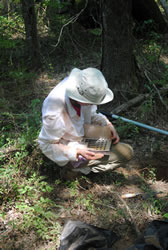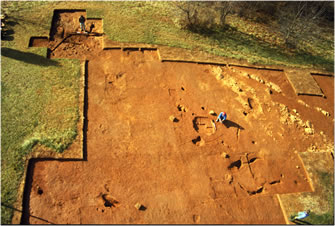Engaging The Piedmont: Transitions in Virginia Slavery 1730-1790
 Most of what archaeololgists know about slavery in Virginia is based on many years of research in the tidewater--the coastal area that was settled in the seventeenth century and the place where many slaves lived in the eighteenth and nineteenth centuries as well. By comparison, relatively few slave sites outside of this region have been excavated or analyzed. The National Endowment for the Humanities has recently funded three years of research that will enable researchers from the University of Tennessee, the University of Massachusetts, Boston and Thomas Jefferson's Poplar Forest to study how slave families and communities formed in the Virginia piedmont (the area between the Tidewater and the Blue Ridge Mountains), and how this change from groups of unrelated strangers to groups of families (or people with long-term, shared experiences) affected living conditions on plantations.
Most of what archaeololgists know about slavery in Virginia is based on many years of research in the tidewater--the coastal area that was settled in the seventeenth century and the place where many slaves lived in the eighteenth and nineteenth centuries as well. By comparison, relatively few slave sites outside of this region have been excavated or analyzed. The National Endowment for the Humanities has recently funded three years of research that will enable researchers from the University of Tennessee, the University of Massachusetts, Boston and Thomas Jefferson's Poplar Forest to study how slave families and communities formed in the Virginia piedmont (the area between the Tidewater and the Blue Ridge Mountains), and how this change from groups of unrelated strangers to groups of families (or people with long-term, shared experiences) affected living conditions on plantations.
 This site focuses on comparing evidence from excavated houses and yards that are associated with a single enslaved community who, between 1730 and 1780, lived at three separate sites in the piedmont: Indian Camp in modern-day Powhatan County, and the Wingo's and North Hill quarters on the Poplar Forest plantation in Bedford County. Archaeologists working at Poplar Forest excavated the North Hill site in the 1990s, and we will use information from that site to compare to the others. Archaeologists have been working at Wingo's for several years, and will continue research there. Indian Camp has not been previously excavated, and constitutes an entirely new piece to this puzzle.
This site focuses on comparing evidence from excavated houses and yards that are associated with a single enslaved community who, between 1730 and 1780, lived at three separate sites in the piedmont: Indian Camp in modern-day Powhatan County, and the Wingo's and North Hill quarters on the Poplar Forest plantation in Bedford County. Archaeologists working at Poplar Forest excavated the North Hill site in the 1990s, and we will use information from that site to compare to the others. Archaeologists have been working at Wingo's for several years, and will continue research there. Indian Camp has not been previously excavated, and constitutes an entirely new piece to this puzzle.
See also: Hidden Lives



